Bairoa, Caguas, Puerto Rico
Bairoa | |
|---|---|
Barrio | |
 Street and shops in Bairoa | |
 Location of Bairoa within the municipality of Caguas shown in red | |
 Bairoa Location of Puerto Rico | |
| Coordinates: 18°15′35″N 66°02′25″W / 18.25977°N 66.040177°WCoordinates: 18°15′35″N 66°02′25″W / 18.25977°N 66.040177°W[1] | |
| Commonwealth | |
| Municipality | |
| Area | |
| • Total | 7.67 sq mi (19.9 km2) |
| • Land | 7.56 sq mi (19.6 km2) |
| • Water | 0.11 sq mi (0.3 km2) |
| Elevation | 194 ft (59 m) |
| Population (2010) | |
| • Total | 19,258 |
| • Density | 2,547.4/sq mi (983.6/km2) |
| Source: 2010 Census | |
| Time zone | UTC−4 (AST) |
Bairoa is a barrio or district in the municipality of Caguas, Puerto Rico. Its population in 2010 was 19,258.[3][4][5]
Name[]
The barrio of Bairoa gets its name from the Bairoa River which crosses the area from west to east and flows into the Loíza River. There are numerous theories about the name meaning of Bairoa. The word bairoa is most likely of Taíno origin and it possibly comes from the word baira, which is either the native name for the tree Chrysophyllum cainito, or a native word meaning "forest", "wood" or "tree bark", or from the word paira meaning "bow".[6][7]
History[]
The area of Bairoa was originally inhabited by the Taíno people. At the time of the Spanish arrival the area was under control of cacique (tribal chief) Caguax, from whom the city of Caguas gets its name. The first European settlement in the area was the Hato de Bairoa, a cattle farm established and developed between the years 1525 and 1600. The first mention of Bairoa as a district of Caguas comes from the colonial municipal budget documents of 1821 as Bairoa Abajo and Bairoa Arriba (modern day Bairoa, Aguas Buenas). During this time the economy of the barrio was primarily the cultivation of sugarcane and minor fruits, and cattle raising.[8]
Puerto Rico was ceded by Spain in the aftermath of the Spanish–American War under the terms of the Treaty of Paris of 1898 and became an unincorporated territory of the United States. In 1899, the United States Department of War conducted a census of Puerto Rico finding that the combined population of Borinquen barrio and Bairoa barrio was 3,870.[9] According to the 2010 United States Census the population of Bairoa is of 19,258 residents, and the barrio today is primarily suburban and residential.
Landmarks and places of interest[]
- and Altos de San Luis, two mountain ridges and secondary forests home to the Puerto Rican plain pigeon.
- , secondary forest between the Valle Verde and Golden Gates neighborhoods.
- Bairoa La 25, original section of the historic Carretera Central along the Loíza River.
- Bairoa Park, baseball field and sports complex.
- Bairoa Shopping Center, one of the oldest shopping centers in Caguas.
- El Mariachi, Mexican-Puerto Rican restaurant popular with locals and visitors alike.
- Monte Calvario Cemetery, crematorium and cemetery.
- , former location of and a sugarcane refinery.
| Historical population | |||
|---|---|---|---|
| Census | Pop. | %± | |
| 1950 | 2,432 | — | |
| 1980 | 14,562 | — | |
| 1990 | 18,189 | 24.9% | |
| 2000 | 19,201 | 5.6% | |
| 2010 | 19,258 | 0.3% | |
| U.S. Decennial Census[10] 1899 (shown as 1900)[11] 1910-1930[12] 1930-1950[13] 1980-2000[14] 2010[15] | |||
Gallery[]

Plaza Centro, Christmas 2012.

View of Caguas and Bairoa (in the foreground) from Altos de San Luis.
See also[]
References[]
- ^ a b "US Gazetteer 2019". US Census. US Government.
- ^ U.S. Geological Survey Geographic Names Information System: Bairoa barrio
- ^ Picó, Rafael; Buitrago de Santiago, Zayda; Berrios, Hector H. Nueva geografía de Puerto Rico: física, económica, y social, por Rafael Picó. Con la colaboración de Zayda Buitrago de Santiago y Héctor H. Berrios. San Juan Editorial Universitaria, Universidad de Puerto Rico,1969.
- ^ Gwillim Law (20 May 2015). Administrative Subdivisions of Countries: A Comprehensive World Reference, 1900 through 1998. McFarland. p. 300. ISBN 978-1-4766-0447-3. Retrieved 25 December 2018.
- ^ Puerto Rico:2010:population and housing unit counts.pdf (PDF). U.S. Dept. of Commerce, Economics and Statistics Administration, U.S. Census Bureau. 2010.
- ^ Payne, D.L. (1991). Handbook of Amazonian Languages. Berlin.
- ^ "Lengua Taína. Diccionario". pueblosoriginarios.com. Retrieved 2021-10-21.
- ^ de Lamadrid Pesant, Katia Gil (1991). Caguas: Transformaciones territoriales desde el período colonial hasta 1952 (in Spanish). Gurabo, Puerto Rico: Universidad del Turabo.
- ^ Joseph Prentiss Sanger; Henry Gannett; Walter Francis Willcox (1900). Informe sobre el censo de Puerto Rico, 1899, United States. War Dept. Porto Rico Census Office (in Spanish). Imprenta del gobierno. p. 161.
- ^ "U.S. Decennial Census". United States Census Bureau. Archived from the original on February 13, 2020. Retrieved September 21, 2017.
- ^ "Report of the Census of Porto Rico 1899". War Department Office Director Census of Porto Rico. Archived from the original on July 16, 2017. Retrieved September 21, 2017.
- ^ "Table 3-Population of Municipalities: 1930 1920 and 1910" (PDF). United States Census Bureau. Archived (PDF) from the original on August 17, 2017. Retrieved September 21, 2017.
- ^ "Table 4-Area and Population of Municipalities Urban and Rural: 1930 to 1950" (PDF). United States Census Bureau. Archived (PDF) from the original on August 30, 2015. Retrieved September 21, 2014.
- ^ "Table 2 Population and Housing Units: 1960 to 2000" (PDF). United States Census Bureau. Archived (PDF) from the original on July 24, 2017. Retrieved September 21, 2017.
- ^ Puerto Rico:2010:population and housing unit counts.pdf (PDF). U.S. Dept. of Commerce Economics and Statistics Administration U.S. Census Bureau. 2010. Archived (PDF) from the original on 2017-02-20. Retrieved 2019-08-02.
- Barrios of Caguas, Puerto Rico
- Puerto Rico Senatorial district VII geography stubs

